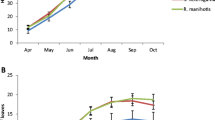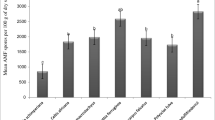Abstract
The association between arbuscular mycorrhizal fungi (AMF) and Rhynchrelyrum repens was investigated. In six abandoned quarries in the Pearl River Delta area, R. repens was found to be associated with nine AMF species, including Glomus versiforme, G. brohultii, G. microaggregatum, G. clarum and G. claroideum, Acaulospora delicata, A. mellea, A. mollowae and Entrophospora infrequens. The genus Glomus and the species G. brohultii were recorded at the highest frequencies. Three typical arbuscular mycorrhizal (AM) structures, i.e. hyphae, vesicles and arbuscules, were found in the roots of the R. repens specimens collected from all the quarries investigated. Vesicles were the most frequently recorded structure. Results of a container-based experiment showed that R. repens had very high mortality (83.3%) in the absence of AMF in soil containing sufficient P (phosphorus); this indicates that R. repens is an obligate mycotroph. The presence of AMF significantly increased the biomass accumulation of R. repens seedlings (p < 0.01). It was also observed that AMF colonization was related to soil P and K (potassium) utilization by R. repens seedlings. It is, therefore, important to inoculate with AMF when using R. repens for the restoration of damaged ecosystems.



Similar content being viewed by others
Abbreviations
- GD:
-
Glomus diaphanum
- GG:
-
Glomus geosporum
- GM:
-
Glomus mosseae
- AMF:
-
Arbuscular mycorrhizal fungi
References
Aerts R (2002) The role of various types of mycorrhizal fungi in nutrient cycling and plant competition. In: Van Der Heijden MGA, Sanders IR (eds) Mycorrhizal ecology. Springer, Berlin, pp 117–131
Allen EB, Allen MF (1980) Natural re-establishment of vesicular-arbuscular mycorrhizae following stripmine reclamation in Wyoming. J Appl Ecol 17:139–147
An ZQ, Hendrix JW, Hershman DE, Henson GT (1990) Evaluation of the most probable number (MPN) and wet-sieving methods for determining soil-borne populations of endogonaceous mycorrhizal fungi. Mycologia 82:516–518
Azcón R, Ambrosano E, Charest C (2003) Nutrient acquisition in mycorrhizal lettuce plants under different phosphorus and nitrogen concentration. Plant Sci 165:1137–1145
Bao YY, Yan W, Zhang MQ (2007) Arbuscular mycorrhizal fungi associated with common plants in grassland of Inner Mongolia. Mycosystema 26:51–58 (in Chinese)
Beauchamp VB, Stromberg JC, Stutz JC (2006) Arbuscular mycorrhizal fungi associated with Populus-Salix stands in a semiarid riparian ecosystem. New Phytol 170:369–380
Brundrett M, Melville L, Peterson L (eds) (1994) Practical Methods in Mycorrhiza Research Mycologue Publications, Guelph
Brundrett M, Jasper DA, Ashwath N (1999) Glomalean mycorrhizal fungi from tropical Australia II. The effect of nutrient levels and host species on the isolation of fungi. Mycorrhiza 8:315–321
Coates DJ, van Leeuwen SJ (1997) Delineating seed provenance areas for revegetation from patterns of genetic variation. In Bellairs SM, Osborne JM (eds) Proceedings of the Second Australian Workshop on Biology for Revegetation. Australian Centre for Minesite Rehabilitation Research, Brisbane, pp 3–15
Collier SC, Yarnes CT, Herman RP (2003) Mycorrhizal dependency of Chihuahuan desert plants is influenced by life history strategy and root morphology. J Arid Environ 55:223–229
Cuenca G, Andrade ZD, Escalante G (1998) Arbuscular mycorrhizae in the rehabilitation of fragile degraded tropical lands. Biol Fert Soils 26:107–111
Cuenca G, Andrade ZD, Lovera M, Fajardo L, Meneses E (2003) Mycorrhizal response of Clusia pusilla growing in two different soils in the field. Trees 17:200–206
Cullen WR, Wheater CP, Dunleavy PJ (1998) Establishment of species-rich vegetation on reclaimed limestone quarry faces in Derbyshire, UK. Biol Conserv 84:25–33
Douds DD, Millner P (1999) Biodiversity of arbuscular mycorrhizal fungi in agroecosystems. Agric Ecosyst Environ 74:77–93
Galvez L, Douds DD, Drinkwater LE, Wagoner P (2001) Effect of tillage and farming system upon VAM fungus populations and mycorrhizas and nutrient uptake of maize. Plant Soil 228:299–308
Gamalero E, Trotta A, Massa N, Copetta A, Martinotti MG, Berta G (2004) Impact of two fluorescent pseudomonads and an arbuscular mycorrhizal fungus on tomato plant growth, root architecture and P acquisition. Mycorrhiza 14:185–192
Harwood D (1990) Aspects of species and provenance selection. In: Stafford J (ed) Sowing the seeds: direct seeding and natural regeneration conference proceedings. Greening Australia, Canberra, pp 127–133
Herrera-Peraza RA, Ferrer RL, Sieverding E (2003) Glomus brohultii: a new species in the arbuscular mycorrhiza forming glomerales. J Appl Bot-Angew Bot 77:37–40
Hetrick BAD, Wilson GWT, Todd TC (1990) Differential responses of C3 and C4 grasses to mycorrhizal symbiosis, P fertilization, and soil microorganisms. Can J Bot 68:461–467
Hetrick BAD, Wilson GWT, Hartnett DC (1992) Relationship of mycorrhizal symbiosis rooting strategy and phenology among tall grass prairie forbs. Can J Bot 67:2608–2615
Janos DP (1980) Mycorrhizae influence tropical succession. Biotropica 12:56–64
Janos DP (2007) Plant responsiveness to mycorrhizas differs from dependence upon mycorrhizas. Mycorrhiza 17:75–91
Jansa J, Mozafar A, Frossard E (2005) Phosphorus acquisition strategies within arbuscular mycorrhizal fungal community of a single field site. Plant Soil 276:163–176
Jentschke G, Brandes B, Kuhn AJ, Schröder WH, Becker JS, Godbold DL (2000) The mycorrhizal fungus Paxillus involutus transports magnesium to Norway spruce seedlings. Evidence from stable isotope labeling. Plant Soil 220:243–246
Kennedy LJ, Tiller RL, Stutz JC (2002) Associations between arbuscular mycorrhizal fungi and Sporobolus wrightii in riparian habitats in arid South-western North America. J Arid Environ 50:459–475
Klironomos JN (2003) Variation in plant response to native and exotic arbuscular mycorrhizal fungi. Ecology 84:2292–2301
Koide RT (1991a) Nutrient supply, nutrient demand and plant response to mycorrhizal symbiosis. Funct Ecol 31:252–255
Koide RT (1991b) Nutrient supply, nutrient demand and plant response to mycorrhizal infection. New Phytol 117:365–386
Koide RT, Li MG (1990) On host regulation of the Vesicular-arbuscular mycorrhizal symbiosis. New Phytol 114:59–74
Koske RE, Tessier B (1983) A convenient, permanent slide mounting medium. Newsl Mycol Soc Am 4:59
Kothari SK, Marschner H, George E (1990) Effect of VA mycorrhizal fungi and rhizosphere microorganisms on root and shoot morphology, growth and water relations in maize. New Phytol 116:303–311
Lu X (ed.) (2001) Study of soil fertilizer. Chinese Agriculture Press, Beijing, China (in Chinese, 428 pp)
McGonigle TP, Miller MH, Evans DG, Fairchild GL, Swan JL (1990) A new method which gives an objective measure of colonization of roots by vesicular arbuscular mycorrhizal fungi. New Phytol 115:495–501
Morte A, Lovisolo C, Schubert A (2000) Effect of drought stress on growth and water relations of the mycorrhizal association Helianthemum almeriense-Terfezia claveryi
Oehl F, Sieverding E, Ineichen K, Mäder P, Boller T, Wiemken A (2003) Impact of land use intensity on the species diversity of arbuscular mycorrhizal Fungi in Agroecosystems of Central Europe. Appl Environ Microbiol 69:2816–2824
Oliveira RS, Castro PML, Dodd JC, Vosátka M (2006) Different native arbuscular mycorrhizal fungi influence the coexistence of two plant species in a highly alkaline anthropogenic sediment. Plant Soil 287:209–221
Page AL, Miller RH, Keeney DR (eds.) (1982) Methods of soil analysis. ASA and SSSA, Madison, Wisconsin
Peterson RL, Bonfante P (1994) Comparative structure of vesicular-arbuscular mycorrhizas and ectomycorrhizas. Plant Soil 159:79–88
Phillips JM, Hayman DS (1970) Improved procedures for clearing roots and staining parasitic and vesicular arbuscular mycorrhizal fungi for rapid assessment of infection. Trans Br Mycol Soc 55:158–160
Ratcliffe DA (1974) Ecological effects of mineral exploitation in the United Kingdom and their significance to nature conservation. Proc R Soc Lond 339:355–372
Reeves FB, Wagner D, Moorman T, Kiel J (1979) The role of endomycorrhizae in revegetation practices in the semi-arid west. I. a comparison of incidence of mycorrhizae in severely disturbed vs. natural environments. Am J Bot 66:6–13
Sagoff M (2005) Do non-native species threaten the natural environment? J Agr Environ Ethics 18:215–236
Schenck NC, Peréz Y (1988) Manual for the identification of VA mycorrhizal fungi, 2nd edn. Synergistic, Gainesville, Fla
Simard SW, Durall D, Jones M (2002) Carbon and nutrient fluxes within and between mycorrhizal plants. In: Van Der Heijden MGA, Sanders IR (eds) Mycorrhizal Ecology. Springer, Berlin, pp 41–42
Smith SE, Read DJ (1997) Section 1: Vesicular- arbuscular mycorrhizas. In Mycorrhizal symbiosis, 2nd edn. Academic, San Diego, pp 54–64
Smith FA, Jakobsen I, Smith SE (2000) Spatial differences in acquisition of soil phosphate between two arbuscular mycorrhizal fungi in symbiosis with Medicago truncatula. New Phytol 147:357–366
Tang HJ, Hu ZQ (2004) On the ecological restoration of quarry. China Mining Magazine 13:38–42 (in Chinese)
Van Der Heijden MGA, Boller T, Wiemken A, Sanders IR (1998) Different arbuscular mycorrhizal fungal species are potential determinants of plant community structure. Ecology 79:2082–2091
Wilson GWT, Hartnett DC (1998) Interspecific variation in plant responses to mycorrhizal colonization in tall grass prairie. Am J Bot 85:1732–1738
Yuan JG, Fang W, Fan L, Chen Y, Wang DQ, Yang ZY (2006) Soil formation and vegetation establishment on the cliff face of abandoned quarries in the early stages of natural colonization. Restor Ecol 14:349–356
Acknowledgements
This work was funded by Guangzhou R&D Program for Key Technologies. We thank Roger T. Koide (Department of Horticulture Penn State University, PA 16802, USA), Helen Y Lee (Oberlin College, Oberlin, OH, 44074, USA) and Yi Luo (Long Island University-Brooklyn Campus, Brooklyn, NY, 11201, USA) for checking our English grammar.
Author information
Authors and Affiliations
Corresponding authors
Additional information
Responsible Editor: Peter Christie
Rights and permissions
About this article
Cite this article
Chen, Y., Yuan, Jg., Yang, Zy. et al. Associations between arbuscular mycorrhizal fungi and Rhynchrelyrum repens in abandoned quarries in southern China. Plant Soil 304, 257–266 (2008). https://doi.org/10.1007/s11104-008-9546-z
Received:
Accepted:
Published:
Issue Date:
DOI: https://doi.org/10.1007/s11104-008-9546-z




